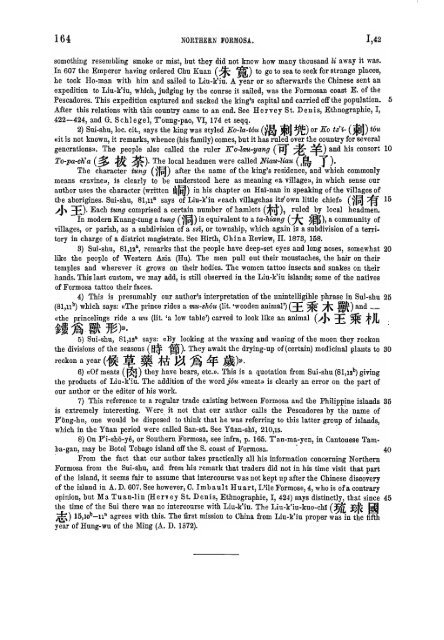Chau Ju-Kua - University of Oregon Libraries
Chau Ju-Kua - University of Oregon Libraries
Chau Ju-Kua - University of Oregon Libraries
You also want an ePaper? Increase the reach of your titles
YUMPU automatically turns print PDFs into web optimized ePapers that Google loves.
164 NORTHERN FOKMOSA. 1,42<br />
somotMng resembling smoke or mist, but they did not know how many thousand U away it was.<br />
In 607 the Emperor having ordered Chu <strong>Kua</strong>n (;^ '^) to go to sea to seek for strange places,<br />
he took Ho-man with him and sailed to Liu-k'iu. A year or so afterwards the Chinese sent an<br />
expedition to Liu-k'iu, which, judging by the course it sailed, was the Formosan coast E. <strong>of</strong> the<br />
Pescadores. This expedition captured and sacked the king's capital and carried <strong>of</strong>f the population. 5<br />
After this relations with this country came to an end. See HerveySt. Denis, Ethnographie, I,<br />
422—424, and G. Schlegel, T'oung-pao, VI, 174 et seqq.<br />
2) Sui-shu, loc. cit., says the king was styled Eo-la-tou ("^^ ^\ ^) or Ko te'i- (^j) tou<br />
«it is not known, it remarks, whence (his family) comes, but it has ruled over the country for several<br />
generations)). The people also called the ruler E'o-lau-yang ("pp -^ :^) and his consort 10<br />
To-pa-ch'a (^^ jj^ ^k)' ^^^ '*"'*' headmen were called Niait-liau (j& J ).<br />
The character tung ('/|3) s^ft^r the name <strong>of</strong> the king's residence, and which commonly<br />
means «ravine)), is clearly to be understood here as meaning «a village)), in which sense our<br />
author uses the character (written |l||n|) in his chapter on Hal-nan in speaking <strong>of</strong> the villages <strong>of</strong><br />
the aborigines. Sui-shu, 81,11" says <strong>of</strong> Liu-k'iu ceach villagehas its' own little chief)) ("^jS ;^ 15<br />
A-\ ^£)- Each tung comprised a certain number <strong>of</strong> hamlets (jpit), ruled by local headmen.<br />
In modern <strong>Kua</strong>ng-tung a tung ('^1^) is equivalent to a ta-hiang {'/^ ^fP)' * community <strong>of</strong><br />
villages, or parish, as a subdivision <strong>of</strong> a ssi, or township, which again is a subdivision <strong>of</strong> a terri-<br />
tory in charge <strong>of</strong> a district magistrate. See Hirth, China Review, II. 1873, 158.<br />
3) Sui-shu, 81,12*, remarks that the people have deep-set eyes and long noses, somewhat 20<br />
like the people <strong>of</strong> Western Asia (Hu). The men pull out their moustaches, the hair on their<br />
temples and wherever it grows on their bodies. The women tattoo insects and snakes on their<br />
hands. This last custom, we may add, is still observed in the Liu-k'iu islands; some <strong>of</strong> the natives<br />
<strong>of</strong> Formosa tattoo their faces.<br />
4) This is presumably our author's interpretation <strong>of</strong> the unintelligible phrase in Sui-shu 25<br />
(81,ii'') which says: «The prince rides a mu-shou (lit. 'wooden animal') C^P ^^ T^J ^^) and<br />
«the princelings ride a loto (lit. 'a low table') carved to look like an animal ("yK ^P ^& i^H,<br />
5) Sui-shu, 81,12* says: «By looking at the waxing and waning <strong>of</strong> the moon they reckon<br />
the divisions <strong>of</strong> the seasons (Q^ '^ff)- Tliey await the drying-up <strong>of</strong> (certain) medicinal plants to 30<br />
reckon a year {^ M M ^'^ ii^ ^ ^ M>-<br />
6) «0f meats (fi!*t) they have bears, etc.». This is a quotation from Sui-shu (81,ia'') giving<br />
the products <strong>of</strong> Liu-k'iu. The addition <strong>of</strong> the word jou ameat)) is clearly an error on the part <strong>of</strong><br />
our author or the editor <strong>of</strong> his work.<br />
7) This reference to a regular trade existing between Formosa and the Philippine islands 35<br />
is extremely interesting. Were it not that our author calls the Pescadores by the name <strong>of</strong><br />
P'6ng-hu, one would be disposed to think that he was referring to this latter group <strong>of</strong> islands,<br />
which in the Yiian period were called San-sii. See Yiian-shi, 210,15.<br />
8) On P'i-sho-y§, or Southern Formosa, see infra, p. 165. T'an-ma-yen, in Cantonese Tamba-gan,<br />
may be Botol Tobago island <strong>of</strong>f the S. coast <strong>of</strong> Formosa.<br />
'<br />
40<br />
From the fact that our author takes practically all his information concerning Northern<br />
Formosa from the Sui-shu, and from his remark that traders did not in his time visit that part<br />
<strong>of</strong> the island, it seems fair to assume that intercourse was not kept up after the Chinese discovery<br />
<strong>of</strong> the island in A. D. 607. See however, C. Imbault Huart, L'ile Formose, 4, who is <strong>of</strong> a contrary<br />
opinion, but Ma Tuan-lin (Hervey St. Denis, Ethnographie, I, 42'1) says distinctly, that since 45<br />
the time <strong>of</strong> the Sui there was no intercourse with Liu-k'iu. The Liu-k'iu-kuo-chI (3E^ 3Sfe |i9<br />
^)<br />
15,io''-ii* agrees with this. The first mission to China from Liu-k'iu proper was in the fifth<br />
year <strong>of</strong> Hung-wu <strong>of</strong> the Ming (A. D. 1372).

















